A sushi roll bento, plus how to make sushi rolls without a sushi mat
Shuffling through the hundreds of photos I've taken of past bentos and such, I dug up this sushi roll bento that I did last summer.
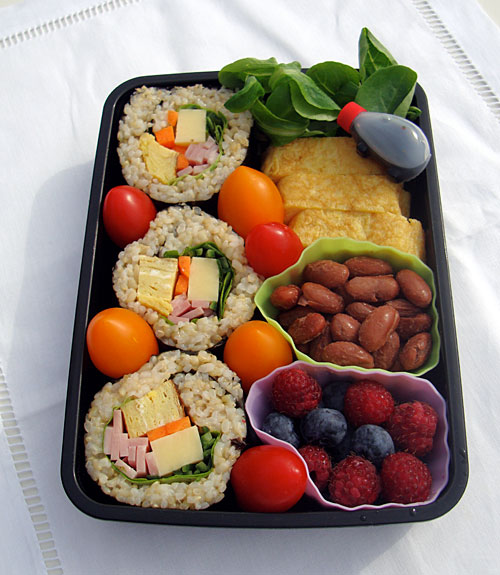
It's a very simple bento really, which is probably why I never got around to posting it here. (I only post a fraction of the bentos I actually make and eat...I should probably post more!) It has a plain tamagoyaki made with 2 eggs, some leftover stewed beans, and fruit. The star of the bento is half of a fat sushi roll made with brown rice that is filled with some decidedly non-traditional things: lettuce, cucumber, raw carrot, ham and cheese, and the end bits of the tamagoyaki. (The rolls are a bit misshapen because I pushed the cherry tomatoes in around them.)
The salt, sugar and vinegar that are used to flavor sushi rice is perfect for summertime bentos. These ingredients help to keep rice fresher for a longer time, and the flavors are a great foil for all kinds of fillings. As a matter of fact, I avoid using brown rice in bentos on the very hottest days, unless I turn it into sushi rice or put an umeboshi pickled plum in to help keep it longer. Fat sushi rolls are just as convenient to eat as onigiri rice balls, and faster to make too, since one roll will produce 4 to 6 portions.
Many people who don't know any better claim that 'real' sushi has to have raw fish. If you've been reading Just Bento and Just Hungry for a while, you know that that's BS. Sushi refers to the rice, not whatever goes in or on top of it; as I explained previously, some areas of Japan don't even have a tradition of raw-fish sushi. In any case, most fat sushi rolls or futomaki traditionally do not contain raw fish, so filling them with cooked food and vegetables is perfectly legit. And in any case, you should never use raw fish in a bento that is made several hours before it's consumed.
Of course ham and cheese are not traditional sushi fillings, but they have been used for decades in Japanese homes, way before the invention of American sushi roll combos like the New York roll (smoked salmon, cream cheese and onion). Sashimi or sushi-grade raw fish is expensive in Japan as it is elsewhere, so homely ingredients make more sense for everyday meals. By the way, I find that milder cheeses go best with sushi rice, such as young Gouda or Emmenthaler (Swiss), or a fresh Mozzarella. A well aged Cheddar or Stilton clashes a bit.
I have some more ideas for non-traditional sushi roll fillings in my ehou-maki (lucky sushi roll) article over on Just Hungry, where I also describe how to roll a fat sushi roll the traditional way using a bamboo sushi rolling mat. But let's say you don't have a sushi mat for whatever reason. You can still make sushi rolls! Here's how.
Method: Making fat sushi rolls without a sushi mat
(The hands in the photos are my mother's by the way - I was the photographer.)
What you need:
- A sheet of nori seaweed
- Properly cooked and prepared sushi rice. It should still be slightly warm, not stone cold, for maximum stick-together-ness.
- Fillings of your choice
- A clean, non-fuzzy kitchen towel
- A sharp kitchen knife
- A bowl filled with water with a little vinegar in it
- Impeccably clean hands
Moisten the kitchen towel and then wring it out tightly. It should just be moist, not dripping.
Lay down the kitchen towel flat. Put the nori sheet shiny side down on the towel; the long edge should be on the edge of the towel. (You put the nori sheet shiny side down because that side has a slightly less tendency to split, and also for aesthetic reasons.)
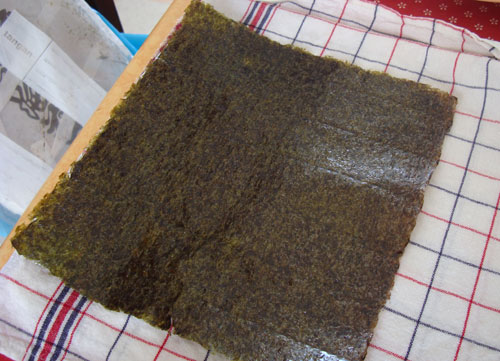
Moisten your fingers with the vinegar-water. Place a fairly thin, even layer of sushi rice on the nori seaweed, up to about an inch (2 cm) away from the far edge of the nori.

Place the fillings in the middle of the rice, starting with any flat ingredients like lettuce or shiso leaves, then following up with the other things like julienned vegetables.
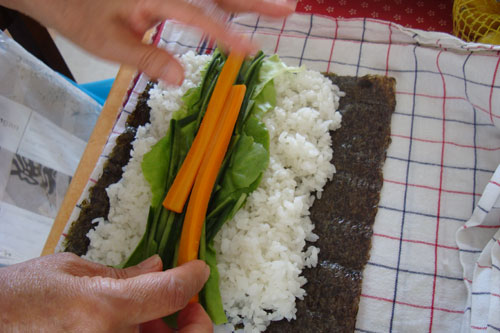
This roll has lettuce, cucumber, carrots, ham and cheese.
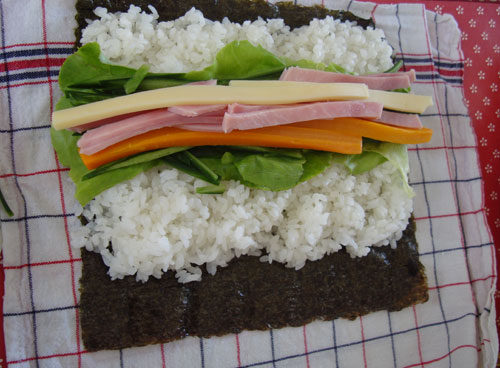
Now you're ready to roll! Re-moisten your fingers with the vinegar water. Grab the edge of the towel with the nori and roll it over the filling, holding in the filling with your fingertips. Be brave here - quick and decisive movement will have better results than hesitation.
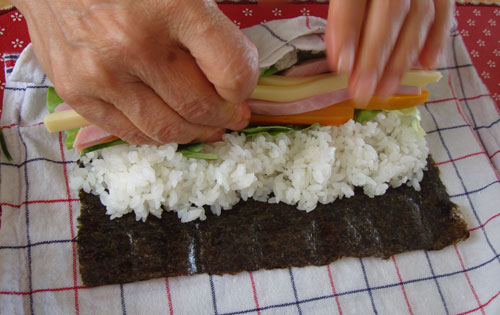
Roll the nori and rice over the filling, as you pull on the edge of the kitchen towel on the other side. If you compare it to the sushi mat method, you'll notice that the method is basically the same.
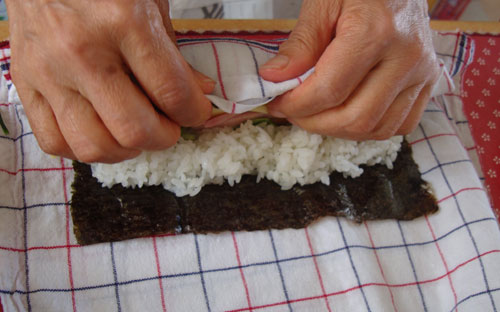
Keep rolling and pulling on the towel, evenly over the length of the roll.
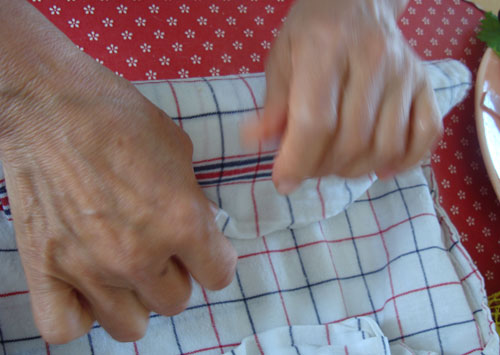
Once the roll is completely rolled, apply gentle but firm, even pressure over the whole thing.
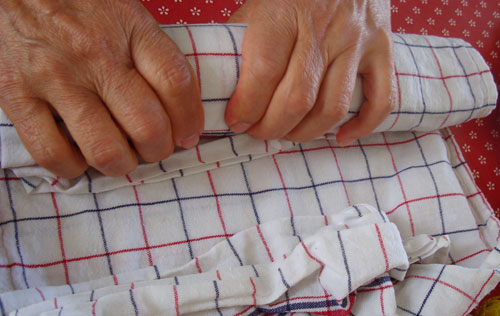
Here's how the roll looks when it's completed, before the towel is removed.
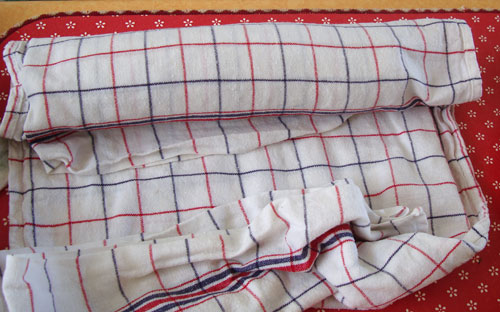
Now you're ready to cut. If there's any rice sticking to your fingers, rinse them off. Moisten the knife and your fingers with the vinegar water.
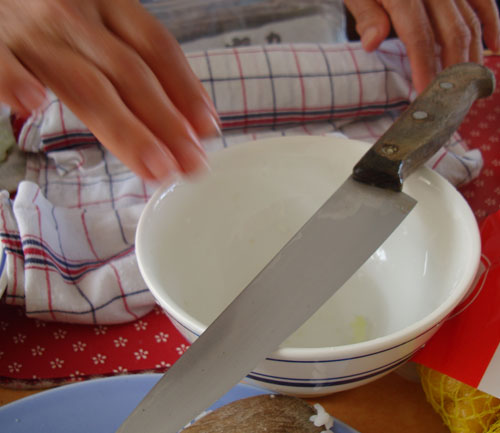
Cut the roll into even pieces. If the knife gets sticky, just re-moisten it with the vinegar water.
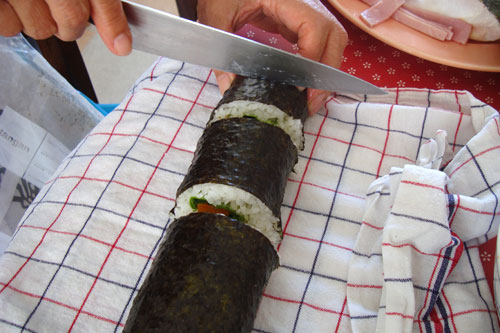
And that's it! It's not as hard as you might have thought, is it?
Here's the end of the roll that I actually used in the bento above. You can tuck in the raggedy end bits good side up in a bento, or just pop them in your mouth as you make them!
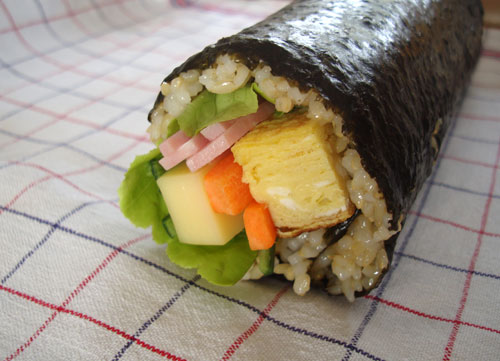
I hope this will inspire you to come up with your own fat sushi roll combinations. Not only are they great for individual bentos, they're a nice change-of-pace carb for a barbeque a picnic too.
If you enjoyed this article, please consider supporting this site by becoming my patron via Patreon.
